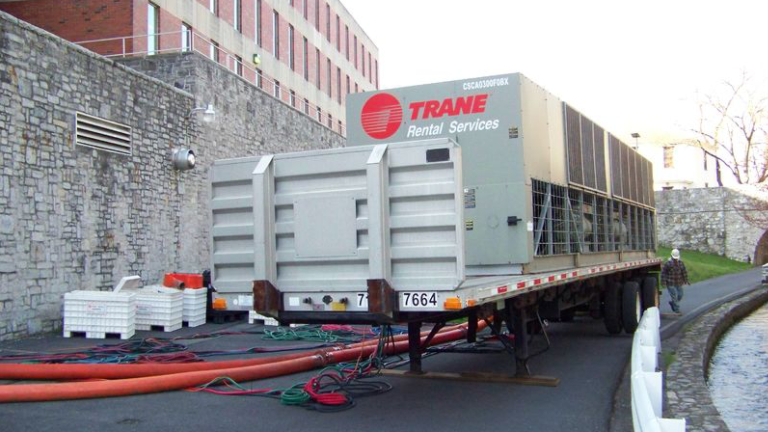Blog
Published: December 01, 2020
Emergency Contingency Planning: Key Best Practices
It’s critical for organizations to have an effective, proactive power and HVAC contingency plan in place. Not only can it reduce financial risk, the contingency plan can help protect the health and safety of building occupants and increase peace of mind for the organization and its stakeholders.
Emergency Contingency Planning: Key Best Practices
December 01, 2020

Most of us are ready to put 2020 and its challenges behind us. Putting aside the pandemic, we have been hit by multiple natural disasters. From running out of letters in the Latin alphabet to name the many hurricanes in the Atlantic Ocean to a record-breaking 4 million acres affected by California fires, it’s clear that we need all to be disaster ready [1]
This is especially true given that these natural events have significantly increased in recent decades. “The nation now spends almost 10 times responding to and recovering from natural events as it did in the 1980s.”[2]
Extreme weather conditions underscore the need for facility teams to prepare for the worst that nature can throw at their buildings. Given their critical missions, healthcare organizations must be prepared to respond quickly and efficiently when a blizzard, flood, tornado, hurricane or other disaster — natural or man-made — strikes.
Given how overextended most healthcare business leaders are from focusing on the current health crisis, the burden of ensuring readiness falls more than ever before on facilities leaders.
Regardless of the disaster and when it occurs, the damage must always be quickly addressed to get the building back online as soon as possible. In hospitals, even a short interruption of electric power or heating, ventilation and air conditioning (HVAC) can put building occupants at risk — potentially causing damage, disrupting operations and eroding the confidence of the community.
Why This Matters: It’s critical for organizations to have an effective, proactive power and HVAC contingency plan in place. Not only can it reduce financial risk, a contingency plan also can help protect the wellbeing and comfort of building occupants and increase peace of mind for the organization and its stakeholders.
Contingency Plans Help Expedite Disaster Recovery
The power and HVAC contingency plan should be integrated into the broader hospital system crisis-preparedness plan.
Below are eight steps healthcare facilities leaders can take to evaluate, analyze, create and implement a contingency plan that meets their specific needs:
1 - Assess the financial, operational and stakeholder impact of a disruption in power or HVAC service. Experienced contingency service providers like Trane® can help hospitals estimate the true costs of unplanned downtime, which go far beyond the cost of repairing mechanical equipment during a time of crisis.
2- Identify potential causes of system failure - including natural disasters, power outages, equipment failures, fires or even sabotage. Rank these causes based on their probability, potential to disrupt normal operations, and financial cost. Remember to include the full range of direct and indirect costs, including equipment repair and replacement costs and the cost of the facility being out of commission for days or even weeks.
3- Conduct a critical system audit to identify mission-essential power and HVAC systems and assess their current operating condition. Address performance problems and document potential failure points. Many organizations will engage a third-party expert like Trane to help with their audit.
4 -Assess your indoor air quality and make necessary adjustments now - Indoor air quality has always been a priority for a cleaner, more comfortable building. Now it’s more important than ever. Consider a fact-based assessment of your building’s air quality with recommendations on where you can improve before disaster strikes.
5 - Identify areas within the hospital that would have the greatest impact on mission-essential operations and the bottom line if an unplanned service interruption were to occur in these areas.
6- Identify reliable, experienced contingency planning consultants and temporary equipment providers. These professionals have proven tools to ensure that the organization develops a complete, effective, and useful contingency plan that does not simply gather dust.
7- Consider the potential need for rental power and HVAC equipment. Temporary equipment ranges from portable dehumidification units that can be used to remove moisture from flooded areas to generators and chilled water systems that can take over the load while the building’s permanent equipment is out of commission. An HVAC rental services company can help develop and implement plans to meet heating and cooling needs when permanent systems are not available or cannot handle the job.
8 - Develop and implement the power and HVAC contingency plan. Provide training and conduct drills to verify the process and identify areas for improvement. Make required building modifications. Review and update the plan each year or when there is a significant change in the facility, such as a building modification or expansion.
Is your organization prepared for its next potential emergency?
Ensure the continuity of power and HVAC services in your hospital environment. Think about creating a robust contingency plan today — before disaster strikes Contact Trane Contingency Planning to take advantage of our contingency planning services.
[1] Kaplan, Sarah, “The undeniable link between weather disasters and climate change,” The Washington Post, Oct. 20, 2020
[2] Ibid
